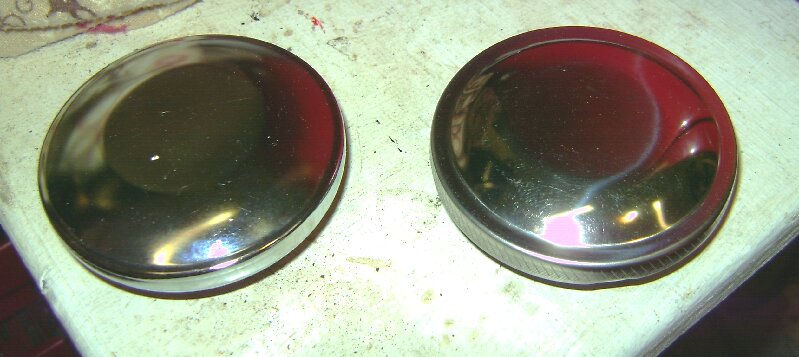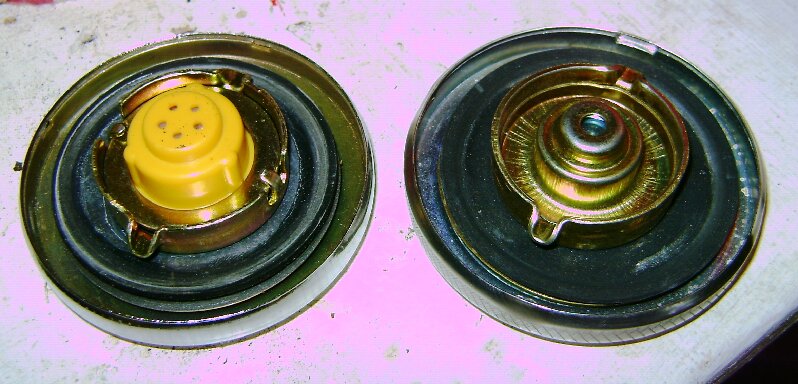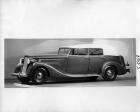|
Re: Fuel Cap
|
||||
|---|---|---|---|---|
|
Home away from home
|
Thanks Bob. Good to know. Glad you got her up and running! I hope to follow soon.
Posted on: 4/10 7:23
|
|||
|
||||
|
Re: Fuel Cap
|
||||
|---|---|---|---|---|
|
Home away from home
|
Thanks Ben!
I should have included a shot for reference. As you can see the tops are identical. On the underside you can see the valve on the left is the one that is too high of a pressure, while the one on the right is from Kanter with the low pressure release. Still having fun!! Bob J.
Posted on: 4/10 8:25
|
|||
|
||||
|
Re: Fuel Cap
|
||||
|---|---|---|---|---|
|
Home away from home
|
Modern pressure/vacuum type gas caps are not suited for use on vehicles made prior to about 1972. Earlier vehicles use a vented gas cap in almost all cases. While some modern-type caps may fit, they will likely cause problems similar to what an original cap with a clogged vent will cause.
(It may now be illegal to manufacture or import vented fuel caps here in the Land of the Free) Older model gas tanks are not designed to hold any significant pressure or vacuum, and old style fuel pumps mounted on the engine will not perform as they should if the gas tank is under any negative pressure. One solution would be to add a vent to an old tank. This would need to be done with care to prevent problems with contaminants entering the tank, and to prevent gasoline from being expelled from the tank under some conditions, and to avoid any chance of allowing gasoline vapor to enter the car body, including the trunk area. Attaching a 3/8 fitting and hose to the upper part of the fill pipe and capping it with a larger style inline filter gas filter and outlet hose might be a good solution, at least on older models. Avoiding dust and road splash at the vent exit would be a must, and the exit would need to be kept as high as practical. Drilling out or otherwise defeating the pressure/vacuum mechanism in a modern style cap might be easier, but that would also need to be done carefully to avoid problems with contaminants or water being able to get into the tank or with gasoline splashing out when making turns with a full gas tank.
Posted on: 4/10 9:58
|
|||
|
||||
|
Re: Fuel Cap
|
||||
|---|---|---|---|---|
|
Home away from home
|
I use a cap like the one on the right (low pressure) on a 1972 Ford pickup, and it definitely causes some pressurization. As I recall, it had a label of some sort attached to the flattened area at the center of the chrome cap.
While it requires very little vacuum to open the vent, it requires significant pressure open it, and when it opens, it makes a honking sound. The '72 Ford pickup cap does fit my '37 Packard, and looks similar to the original. Putting a pressure/vacuum cap on a car in storage might help keep condensation out of the tank and prevent decay of ethanol-adulterated gasoline. I'd prefer an original type cap, but the low pressure type cap ought to work, and they do have a good gasket that is not affected by ethanol. ANY restriction that can cause negative pressure in the tank will aggravate issues with fuel delivery, especially in hot weather, and any pressure cycling of an old tank could aggravate any tendency to leak. With a sound tank, some mild over pressure should not cause any problems, and it could help with vapor lock problems in hot weather.
Posted on: 4/10 10:01
|
|||
|
||||
|
Re: Fuel Cap
|
||||
|---|---|---|---|---|
|
Home away from home
|
The originals as these two that I found in my stock were very basic and, while I can’t quite make out how they vent, I know they do. These were from my 1939 and 1940 and are very slightly different from one another but the difference is almost imperceptible.
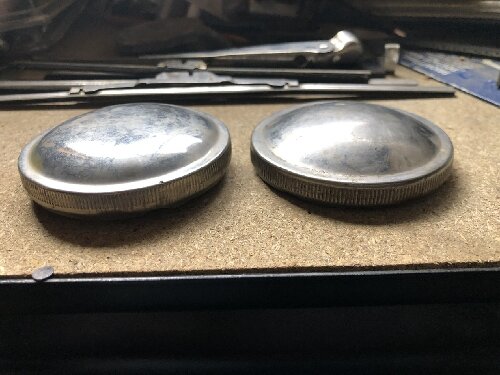  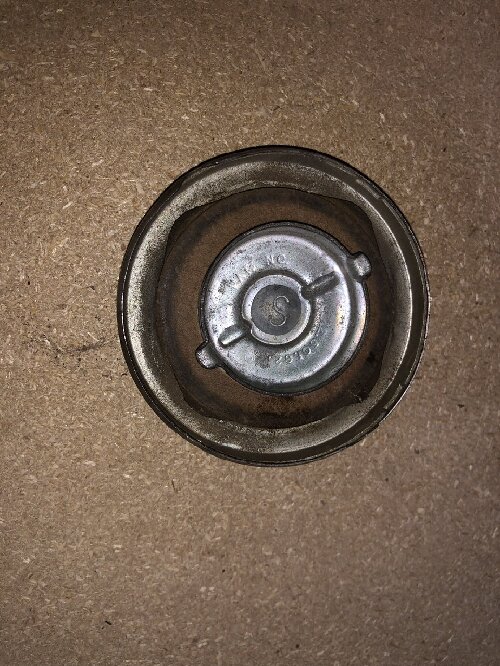
Posted on: 4/10 10:57
|
|||
|
||||
|
Re: Fuel Cap
|
||||
|---|---|---|---|---|
|
Home away from home
|
The one on my '37 120 is different. It is rather heavy, and a little larger OD than the ones pictured, and it appears to have a chromed, die-cast cover. It may be original.
It has a pinhole vent and baffle, and inside the baffle there's a tiny coiled brass tube that's prone to clogging. The gasket looks to be some sort of fiber material.
Posted on: 4/10 11:40
|
|||
|
||||
|
Re: Fuel Cap
|
||||
|---|---|---|---|---|
|
Webmaster
|
The one that came on my 37 when I got it was much larger than expected. It was for a senior car or an earlier one, not sure. The junior caps are smaller in diameter, even though the neck is the same.
Posted on: 4/10 15:29
|
|||
|
-BigKev
1954 Packard Clipper Deluxe Touring Sedan -> Registry | Project Blog 1937 Packard 115-C Convertible Coupe -> Registry | Project Blog |
||||
|
||||

 Cap comparison 1.JPG (1,152.24 KB)
Cap comparison 1.JPG (1,152.24 KB)